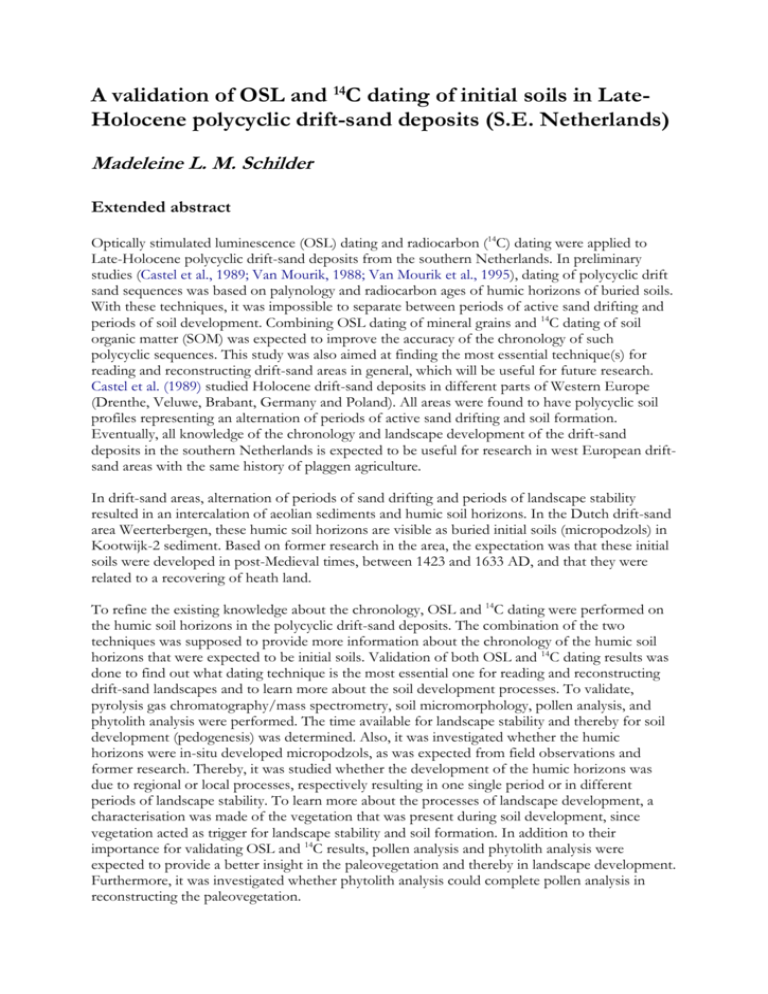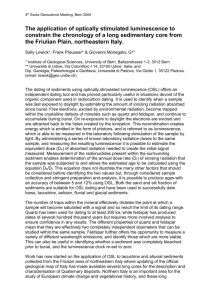A validation of OSL and 14C dating of initial soils in Late
advertisement

A validation of OSL and 14C dating of initial soils in LateHolocene polycyclic drift-sand deposits (S.E. Netherlands) Madeleine L. M. Schilder Extended abstract Optically stimulated luminescence (OSL) dating and radiocarbon (14C) dating were applied to Late-Holocene polycyclic drift-sand deposits from the southern Netherlands. In preliminary studies (Castel et al., 1989; Van Mourik, 1988; Van Mourik et al., 1995), dating of polycyclic drift sand sequences was based on palynology and radiocarbon ages of humic horizons of buried soils. With these techniques, it was impossible to separate between periods of active sand drifting and periods of soil development. Combining OSL dating of mineral grains and 14C dating of soil organic matter (SOM) was expected to improve the accuracy of the chronology of such polycyclic sequences. This study was also aimed at finding the most essential technique(s) for reading and reconstructing drift-sand areas in general, which will be useful for future research. Castel et al. (1989) studied Holocene drift-sand deposits in different parts of Western Europe (Drenthe, Veluwe, Brabant, Germany and Poland). All areas were found to have polycyclic soil profiles representing an alternation of periods of active sand drifting and soil formation. Eventually, all knowledge of the chronology and landscape development of the drift-sand deposits in the southern Netherlands is expected to be useful for research in west European driftsand areas with the same history of plaggen agriculture. In drift-sand areas, alternation of periods of sand drifting and periods of landscape stability resulted in an intercalation of aeolian sediments and humic soil horizons. In the Dutch drift-sand area Weerterbergen, these humic soil horizons are visible as buried initial soils (micropodzols) in Kootwijk-2 sediment. Based on former research in the area, the expectation was that these initial soils were developed in post-Medieval times, between 1423 and 1633 AD, and that they were related to a recovering of heath land. To refine the existing knowledge about the chronology, OSL and 14C dating were performed on the humic soil horizons in the polycyclic drift-sand deposits. The combination of the two techniques was supposed to provide more information about the chronology of the humic soil horizons that were expected to be initial soils. Validation of both OSL and 14C dating results was done to find out what dating technique is the most essential one for reading and reconstructing drift-sand landscapes and to learn more about the soil development processes. To validate, pyrolysis gas chromatography/mass spectrometry, soil micromorphology, pollen analysis, and phytolith analysis were performed. The time available for landscape stability and thereby for soil development (pedogenesis) was determined. Also, it was investigated whether the humic horizons were in-situ developed micropodzols, as was expected from field observations and former research. Thereby, it was studied whether the development of the humic horizons was due to regional or local processes, respectively resulting in one single period or in different periods of landscape stability. To learn more about the processes of landscape development, a characterisation was made of the vegetation that was present during soil development, since vegetation acted as trigger for landscape stability and soil formation. In addition to their importance for validating OSL and 14C results, pollen analysis and phytolith analysis were expected to provide a better insight in the paleovegetation and thereby in landscape development. Furthermore, it was investigated whether phytolith analysis could complete pollen analysis in reconstructing the paleovegetation. 14 C ages provided an estimation of the age of the humic acids of the humic soil horizons. The radiocarbon ages are correlated with the SOM of the humic soil horizons. OSL ages represented the burial ages of the mineral samples above and below the micropodzol. A large discrepancy between the OSL and 14C ages was observed (table A). Surprisingly, in all profiles 14C ages turned out to be older than burial (OSL) ages. Table A OSL and 14C results for all sampled profiles in Weerterbergen. OSL ages in y AD with 1σ (NCL, Delft) and radiocarbon ages in cal y AD. Profile Sample Depth (m) Technique Ages (cal y AD) Def-1 unknown unknown OSL 1910 +/- 10 Def-1 GrN-14458 unknown radiocarbon 1423 - 1633 Def-1 unknown unknown OSL 1650 +/- 30 Bos-1 5106010 0.63 OSL 1961 +/- 2 Bos-1 GrN-29960 0.67 radiocarbon 1528 - 1952 Bos-1 5106011 0.72 OSL 1819 +/- 10 Mad-1 5106012 0.38 OSL 1922 +/- 5 Mad-1 GrN-29959 0.42 radiocarbon 971 - 1225 Mad-1 5106013 0.47 OSL 1896 +/- 5 Mad-2 5106014 0.34 OSL 1981 +/- 1 Mad-2 GrN-29961 0.39 radiocarbon 1222 - 1395 Mad-2 5106015 0.43 OSL 1890 +/- 6 Mad-3 5106016 0.35 OSL 1993 +/- 1 Mad-3 GrN-29962 0.38 radiocarbon 1955-1956 Mad-3 5106017 0.42 OSL 1989 +/- 1 Mad-4 5106018 0.39 OSL 1943 +/- 3 Mad-4 GrN-29964 0.42 radiocarbon 1297 - 1440 Mad-4 5106019 0.47 OSL 1878 +/- 6 Mad-5 5106020 0.40 OSL 1795 +/- 11 Mad-5 GrN-29963 0.43 radiocarbon 340 - 766 Mad-5 5106021 0.48 OSL 1801 +/- 11 OSL ages were interpreted to be the most reliable ages for determining the chronology of the polycyclic drift-sand deposits. First, because all samples were very suitable for OSL dating. Second, because the origin of the OSL samples was not important, but that of the 14C samples was. Moreover, the 14C ages turned out to represent ages of a mix of relatively young organic material, charcoal, and relatively old organic material, of which the latter two were expected to be blown-in from older sources (burial mounds and Twente podzols respectively) in the Weerterbergen area. The presence of charcoal in the humic soil horizons was confirmed by the soil micromorphological results. Third, because results of the soil micromorphological study concerning in-situ soil development were in line with the OSL ages. Last, pollen results, especially the presence of Pinus pollen, provided another proof of the reliability of the OSL ages. According to the results of the soil micromorphological study, profiles Def-1, Bos-1, Mad-1, Mad-2, Mad-3, and Mad-4 turned out to be in-situ developed initial soils (micropodzol), since they all contained in-situ formed organic material of excremental origin. Profile Mad-5 turned out to be one big sediment in which parts contained blown-in organic material and roots. All sediments turned out to be deposited very recently: between 1650 and 1993 AD. This was not in range with results of former studies performed in the drift-sand area Weerterbergen (Van Mourik, 1988; Van Mourik et al., 1995). In these studies the humic soil horizons were stated to be developed in post-Medieval times (between 1423 and 1633 AD); these conclusions were based on 14 C ages and palynology. Because of the reliability of OSL ages, results of this present study were expected to be more accurate and reliable than results of these former studies. Both the length and the start of the time available for landscape stability and soil development did vary among the different profiles, from 292 years (Def-1) to 3 years (Mad-3). The differences in ratio of tree – shrubs/herbs pollen of the different profiles could be linked successfully to these differences in time available for soil development. There turned out to be not one single period of landscape stability. Consequently, development of the humic soil horizon was expected to be due to local conditions, and not to regional fluctuations in landscape stability. Pollen results showed that the vegetation did differ among the different profiles. The paleovegetation was a mix of regional and local species. Pinus pollen were present in all samples, except for Mad-5, which turned out to be no micropodzol. Since Pinus was planted by men only from 1800 AD on (Van Mourik and Dijkstra, 1995), presence of Pinus pollen in the humic soil horizon confirmed the development of the horizon after 1800 AD. The soil development of the initial soils (micropodzols) studied in this present research, was not only expected to be related to a recovering of heath land, as was stated by former research (Van Mourik, 1988; Van Mourik et al., 1995), but for all but one profile (Mad-5), it was expected to be correlated with presence of both Pinus and Ericaceae during soil development. Phytolith spectra could not be prepared for three reasons: reference phytoliths could not be clearly distinguished in reference slides; during the micromorphological study, phytoliths could not be found in thin sections; the prepared phytolith slides were extremely disturbed by crystals or clay particles. Unfortunately, it had to be concluded that phytolith analysis could not complete pollen analysis and the reconstruction of paleovegetation in this research. This research did indeed refine the existing knowledge of the chronology and landscape development of the drift-sand deposits in the southern Netherlands by applying OSL dating, 14C dating, pyrolysis gas chromatography/mass spectrometry, soil micromorphology, and pollen analysis. The research contributed to utilization of OSL dating in paleo-ecological research. OSL dating turned out to be an essential tool for getting insight in Late-Holocene polycyclic drift-sand deposits. 14C dating of these humic soil horizons in the aeolian environment alone would lead to erroneous interpretation, due to the complex composition of the SOM. However, 14C ages, combined with pyrolysis gas chromatography/ mass spectrometry, are expected to help providing a better insight in the complexity of the SOM. The combination of pollen analysis and micromorphology showed to be essential for learning more about the vegetation that acted as a trigger for and was present during local periods of landscape stability and soil development. Studying phytoliths in soil sediments was, like OSL dating, quite pioneering. Results of phytoliths analysis were expected to complete pollen results in the reconstruction of paleovegetation, but this turned out not to be the case. This innovative multidisciplinary research showed that the combination of OSL dating, 14C dating, pyrolysis gas chromatography/mass spectrometry, soil micromorphology and pollen analysis is essential for reading and reconstructing drift-sand landscapes. Keywords: polycyclic drift-sand deposits, initial podzol, OSL dating,14C dating, paleo-ecological reconstruction, soil micromorphology, soil organic material




